What Flour Does In Cake Batter
In this article we’ll examine what is arguably the most important ingredient in cake batter, flour.
In this series of “Cake Batter” classes we’re using the traditional “quatre quarts” pound cake recipe as a tool to understand the baking science of cake batter.
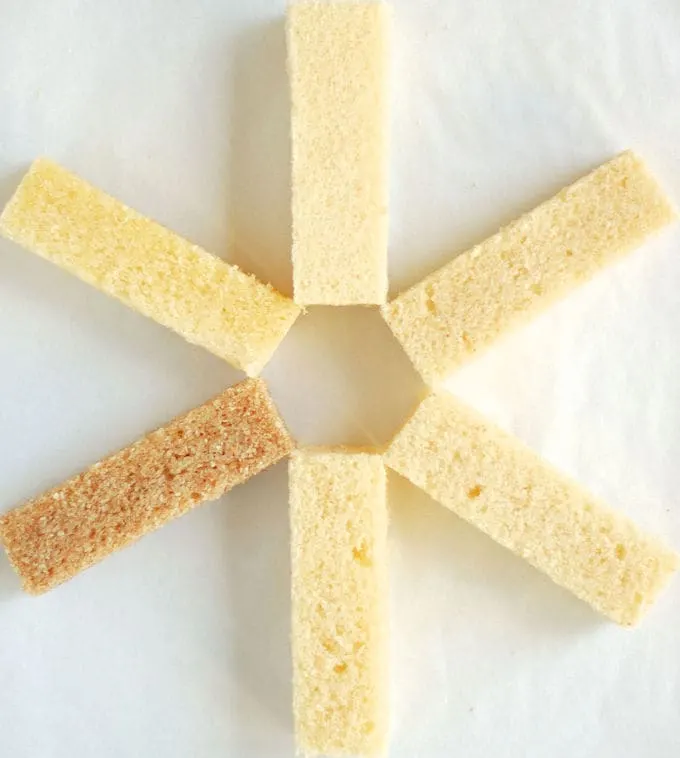
A successful cake formula balances the four main ingredients – flour, sugar, fat and eggs.
Each of those ingredients has an important role in the recipe. The flour and eggs form the structure of the cake with a network of proteins and starch. Butter and sugar provide flavor and moisture, but weaken the cake’s structure.
In a successful cake, the ingredients that strengthen the cake structure (flour and eggs) are balanced with the ingredients that weaken the cake structure (sugar and fat).
To create a moist, sweet and tender cake that bakes up with a nice even crumb the four main ingredients have to work together.
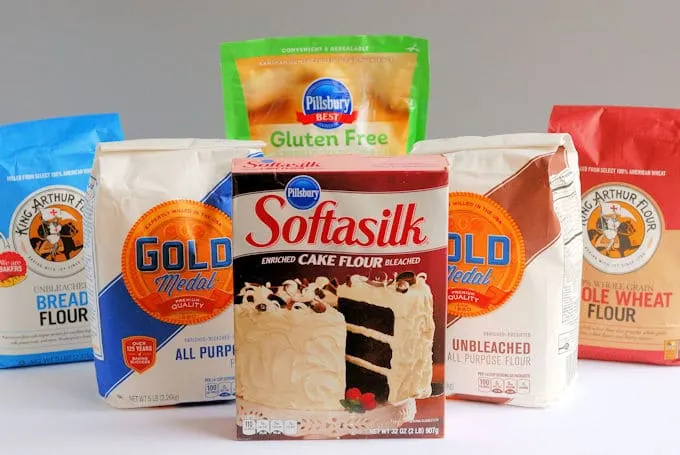
What Flour does in Cake Batter
Although the four ingredients of the original pound cake recipe are equal in weight, flour has the greatest volume.
Wheat flour is composed of proteins, starch, lipids, sugars and enzymes. The two most important of these components, the starch and the protein, form the cake “crumb”.
The cake crumb is a network of starch and protein interspersed with millions of tiny air bubbles. To learn lots of detailed information about the science of flour, and the composition of different flours, please visit the Baking Ingredients – Flour page.
For cake batter, stronger gluten is not desirable so we have to limit it’s formation. How do we do that? We’ve already taken a few steps with our recipe to impede the gluten formation.
The reverse creaming method limits gluten formation by coating the flour proteins with fat before liquid is added. Limiting the amount of salt in the recipe helps, since salt will strengthen gluten.
The easiest way to control the amount of gluten in the cake batter is to use a flour with a lower protein content.
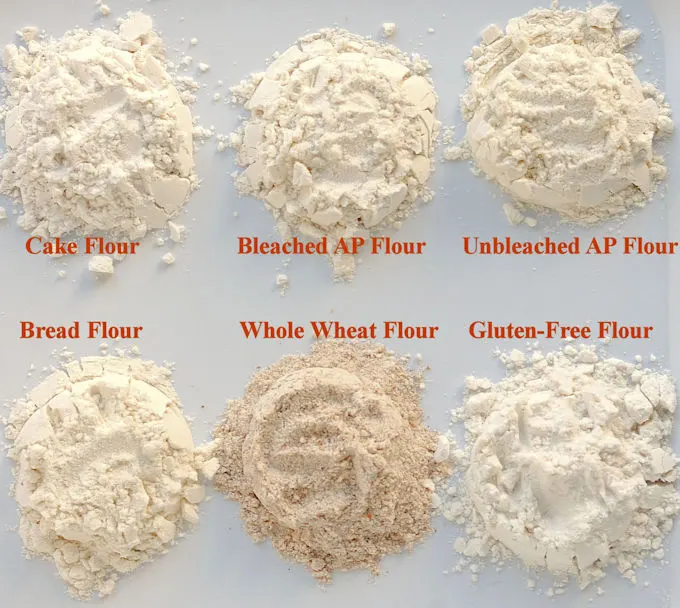
What is Cake Flour?
Cake flour is a finely ground flour made from low protein, soft wheat and is often chlorinated (bleached).
Why Chlorinated or bleached flour makes a softer cake
Chlorination makes cake flour slightly acidic, which weakens the gluten. Chlorination also alters the starch so that it can absorb more liquid and allows the fat in the batter to bind better with the starch.
A cake made with chlorinated flour has a stronger starch gel, a weaker gluten network and very evenly distributed fat molecules. The result is a cake with a tender and fine crumb.
How to make your own cake flour
In a pinch you can substitute all purpose flour for cake flour. For each cup of cake flour use ¾ cup of all purpose flour plus 2 tablespoons of corn starch. This will lower the protein content, but the results will not be exactly the same since all purpose flour is not chlorinated.
How to replace some flour with cocoa to make a chocolate cake
To make a chocolate cake you can replace some of the flour in the recipe with cocoa. Cocoa has starch and protein so it will absorb some water and contribute to the cake structure, as flour does. Replace equal amounts of flour with cocoa. For example, if you add 2 oz of cocoa to a cake batter, reduce the flour by 2 oz.
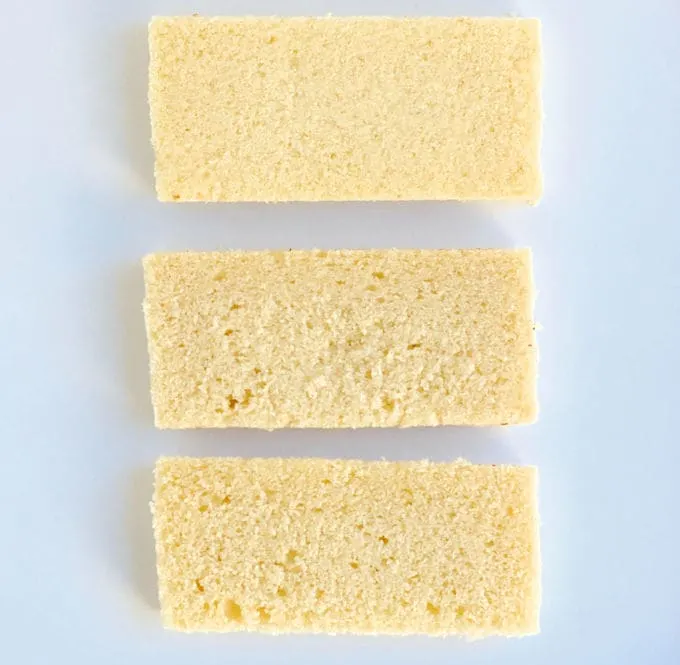
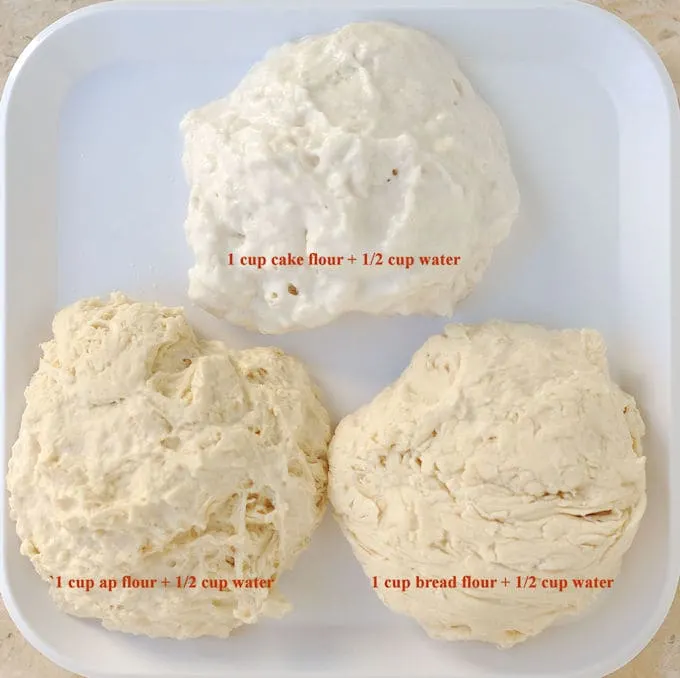
Gluten-Free Pound Cake:
Although a lot of our efforts with the pound cake recipe have been to avoid forming too much gluten in the batter, some gluten is needed to give the cake it’s structure.
Gluten-free recipes use non-wheat flours that don’t contain gluten. When using gluten-free flour, a binding agent must be added to the batter to replace the elasticity lost without the presence of the wheat flour protein.
The flour I used contains rice flour, potato starch, pea fiber, tapioca starch and xanthan gum. The xanthan gum acts as a binder to replace the structure provided by wheat gluten.
Testing Gluten Free Pound Cake
First I made our pound cake recipe using the reverse creaming method. The cake made with the gluten-free flour was significantly flatter than the cakes baked with wheat flour. This was not surprising since gluten helps the cake keep it’s shape while it rises in the oven. Without gluten the structure is weaker so the gluten-free cake can’t rise as high as a cake made with wheat flour.
Since I didn’t have to worry about gluten toughening the cake crumb, I tried mixing the cake using the creaming method to incorporate more air bubbles and, hopefully, get some extra rise on the cake.
The second test was more successful. The gluten-free cake made with the creaming method baked up a little higher and lighter than the cake made with the reverse creaming method. Once again showing that mixing method does matter for successful baking.
After continued experimentation I created a better Gluten Free Pound Cake recipe. It is available exclusively in my Perfecting Pound Cake eBook.
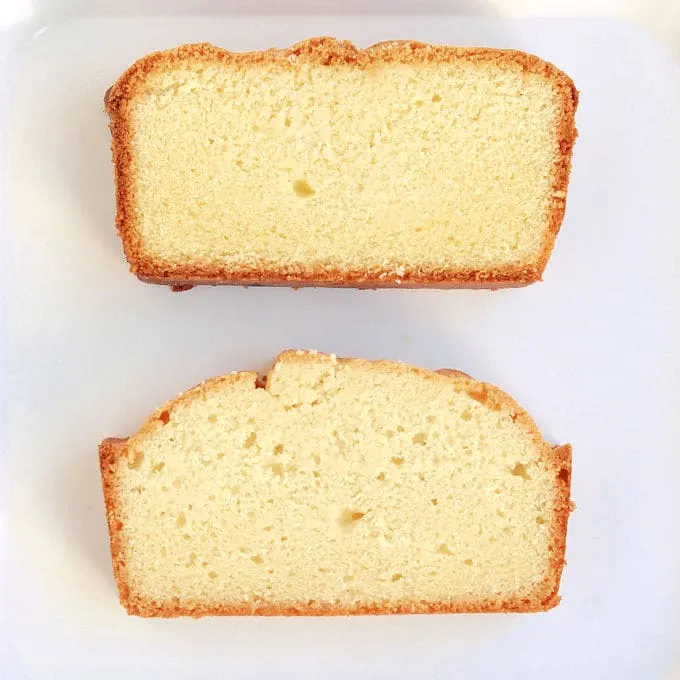
Other cake batter classes:
Next up: Cake Batter Class #4 will explore the function of eggs in a pound cake recipe.
- About Reverse Creaming
- The function of eggs in cake batter
- The function of sugar in cake batter
- The function of fat in cake batter
- The Cake recipe formula
When we’re done experimenting with all the ingredients for this “cake batter” course, we’ll use all we’ve learned to create Pound Cake Perfection.


Most of my cake recipes are British, and call for self-raising flour. I try to always bake with organic ingredients and have not been able to find organic self-raising flour in the US. Instead I use organic all-purpose flour and add baking powder.
What’s your recommended formula for converting all-purpose flour to self-raising? I’ve read that 4 oz of self-raising flour = 4 oz of a combination of all-purpose flour + 1.5 tp baking powder and 0.25 tsp salt? What’s your opinion of this ratio? Does this seems like too much baking powder and/or salt to you?
That looks like the correct ratio according to several well-regarded ingredients websites including King Arthur Flour and Bob’s Red Mill. Generally, you need about a teaspoon of baking powder to lift a cup of flour. But other factors can affect how a baked good rises. If you’re using it in a recipe specifically written for self rising flour then I would go with this standard ratio. You’d have to assume the recipe was written for this amount of baking powder.
Eileen, I was hoping you could clarify how different flours handle different amounts of liquid. In “What is Cake Flour?” you mention that cake flour absorbs more liquid saying: “Chlorination also alters the starch so that it can absorb more liquid.” I noticed this echoed in the Honey Pound Cake recipe as well when you said “using chlorinated cake flour enabled me to add more liquid to the batter.”
The part where I get lost is the captioned photo of different flours with a 1/2 cup of water: “Higher protein flours will absorb more water than lower protein flours.” In the photo, the cake flour isn’t absorbing the water as well at the all-purpose flour. Can you help me understand the difference here?
Thanks for the question. To clarify, when I talk about cake flour I’m not only referring to a lower protein flour, but a flour is that is more finely ground and (usually in the US) bleached. When I talk about cake flour absorbing more liquid I’m specifically comparing chlorinated flour to non-chlorinated flour. Higher protein flour will absorb more water than lower protein flour, but the finely ground and bleached cake flour will absorb more liquid than a lower protein flour that is not “cake” flour. I hope this makes sense.
just typed my question re my mother’s 50 year old pound cake recipe… meant that the recipe calls for 3 teaspoons baking powder…. yikes… not 3T (1 T)
Wow, this proves the baking powder class further! I love this baking science series.
My mother’s pound cake recipe (from 50 years ago) calls for 3 C sugar, 3 C flour, 1 C milk, 3 T baking powder, 6 eggs, 1/2 pound butter and 1/2 C crisco and the directions say: Combine all ingredients and beat on high speed for 5 1/2 minutes. Her pound cake result was always perfect. When I duplicate this recipe, I end up with a cake that falls. Any suggestions? I think it might have to do with the way I combine the butter/crisco and sugar…. I’ve already tested oven temp, changed pans, new baking powder.. so it seems that the problem lies in the way I am combining ingredients. I love this recipe and want to pass it down to my grandchildren, but I don’t want them to have the same problem
First of all, after 30 years it still surprises me that two people can use the exact same recipe and get different results. I saw it all the time in pastry school. Your mom maybe had certain things she did with the recipe that she didn’t write down. Her oven, pans, etc were all different. What type of flour did she use? Are you using the same flour. The formula for crisco has changed over the years. But looking at the recipe I could see why the cake could fall.
Before I get into the specifics of the recipe, I do suggest you read How To Create The Best Cake Recipes to learn about the cake formula. You’ll need to refer to that to follow what I’m saying. When I translate your mother’s recipe into weights it shows that the recipe has more cake tenderizers than cake structure builders. There is more sugar than flour and more fat than eggs. There is also a good amount of liquid. All these things make a cake more tender. A tender cake can fall more easily than a tough cake.
A couple of suggestions. Have you tried baking the cake in a tube or bundt pan? Because they bake from the center and sides a cake is less likely to fall. Do you literally just mix the ingredients all at once? Have you tried mixing it with the creaming or reverse creaming method?
How about pastry flour for cakes, whole wheat and regular?
Pastry flour is between all purpose and cake flour as far as protein content. It would work for cakes, but they wouldn’t be quite as soft. Also, cake flour is bleached. Beaching also makes for a softer cake. But if you don’t like bleached flour pastry flour should make an acceptable cake.
cool
Altitude where we live is around 70ft above sea level so altitude shouldn’t be a problem.
What I usually used in GA was White Lily AP flour. It is hard to find here. I have tried Gold Medal and Pillsbury. I have never used Cake flour because my mom always used the White Lily for this pound cake recipe. I will try your pound cake recipe using cake flour. I will also try using the cake flour for my mom’s recipe. I love pound cake so I’m trying to find a recipe that will work here. Thanks again for your reply and your help.
Ah, I see. If you’ve been replacing White Lily with a national brand AP flour you could get a very different outcome. White Lily flour has a protein content of about 9g. National brands of AP flour (Gold Medal, Pillsbury, King Arthur, Heckers) have protein contents between 11-13g. Cake Flour (Swans Down, Softasilk) has a protein content of 8g. So your White Lily flour is much closer to cake flour than AP flour. I would defintely give both recipes a try using cake flour. Just for you information, I use Softasilk flour when creating my cake recipes.
Do you sift the dry ingredients? Before or after measuring?
I have moved from Georgia to Washington and my “tried and true” pound cake recipe does not work in Washington. The cake top is crumbly and the sides fall right off of the cake when I remove it from the pan.
Thank you for your help!!!
Hi Karen, here’s a link to a pound cake recipe. I do sift the dry ingredients. Did you move to Washington DC or Washington state?
Hi Eileen,
We moved to Washington state. According to other bakers here, altitude is not an issue. I can not find the same name brands of ingredients as I used in Georgia. Wondered if that was an issue. Looking forward to trying your pound cake recipe. I’ll keep you posted. Would have loved to have been your “taste tester”? Thanks for your help.
Karen
I was wondering if it was an altitude issue, that’s why I asked which Washington. Do you know what the altitude is where you’re at? Brands could make a difference. What brand of flour had you been using in Georgia?